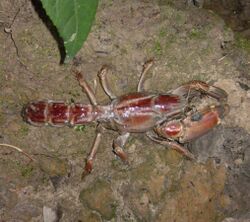Biology:Thalassina anomala
| Thalassina anomala | |
|---|---|

| |
| Scientific classification | |
| Domain: | Eukaryota |
| Kingdom: | Animalia |
| Phylum: | Arthropoda |
| Class: | Malacostraca |
| Order: | Decapoda |
| Suborder: | Pleocyemata |
| Family: | Thalassinidae |
| Genus: | Thalassina |
| Species: | T. anomala
|
| Binomial name | |
| Thalassina anomala (Herbst, 1804)[1]
| |
| Synonyms[2] | |
| |
Thalassina anomala, known as the scorpion mud lobster, is a species of crustacean in the family Thalassinidae.
Description
Thalassina anomala are typically 16–20 centimetres (6.3–7.9 in) in length, with records of specimens up to 30 centimetres (12 in) long.[3] Its body is yellow to reddish-brown.
Distribution
T. anomala is found in the Indo-West Pacific region.[3] It is the most common decapod crustacean in the Sundarbans in India and Bangladesh, though it is often overlooked in traditional sampling efforts.[4]
Ecology and behavior
Its habitat includes littoral and supralittoral zones such as those in mangroves and estuaries.[3] Excavated mud from their nighttime burrowing activities can form hills that reach heights of 3 metres (9.8 ft).[5] The burrows are estimated at 2.5 metres (8.2 ft) in depth. In the monsoon season, its muddy nest becomes saturated with water and submerges, and the lobster is exposed, allowing it to be easily caught.[6]
T. anomala is considered of high importance ecologically, as its nightly burrowing pushes deep soil to the surface, while also helping the import of aerated tidal water up to 2.5 meters deep.[7] The mud mounds provide habitat for other animals including Odontomachus malignus (an ant), termites, Episesarma singaporense (tree-climbing crab), Wolffogebia phuketensis (mangrove mud shrimp), Acrochordus granulatus (file snake), and plants such as the tree Excoecaria agallochoa and ferns.[5]
References
- ↑ "Thalassina anomala". Integrated Taxonomic Information System. https://www.itis.gov/servlet/SingleRpt/SingleRpt?search_topic=TSN&search_value=553060. Retrieved 2018-09-23.
- ↑ G. Poore (2010). "Thalassina anomala Herbst, 1804". WoRMS. World Register of Marine Species. http://www.marinespecies.org/aphia.php?p=taxdetails&id=477807.
- ↑ 3.0 3.1 3.2 "Marine Species Identification Portal : Scorpion mud lobster - Thalassina anomala" (in en). http://species-identification.org/species.php?species_group=lobsters&id=75.
- ↑ Nickell, Lois A.; Atkinson, R. James A. (1995). "Functional morphology of burrows and tropicmodes of three thalassinidean shrimp species". Marine Ecology Progress Series 128: 181–197. doi:10.3354/meps128181.
- ↑ 5.0 5.1 "Mud Lobster (Thalassina anomala) in A Guide to Mangroves of Singapore". http://mangrove.nus.edu.sg/guidebooks/text/2064.htm. Retrieved 2018-09-23.
- ↑ "Keenakan tersembunyi di sebalik busut lumpur" (in ms). BH Online. 2016-01-06. https://www.bharian.com.my/node/111455.
- ↑ Dubey, Sourabh; Choudhury, Amalesh; Chand, Bimal; Kumar Trivedi, Raman (2012-07-01). Ecobiological study on burrowing mud lobster Thalassina anomala (Herbst, 1804) (Decapoda: Thalassinidea) in the intertidal mangrove mudflat of Deltaic Sundarbans. 2. https://www.researchgate.net/publication/280718477.
Wikidata ☰ Q6496220 entry
 |

